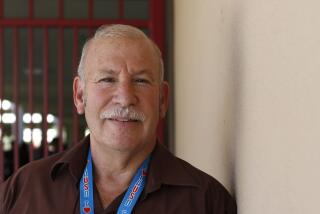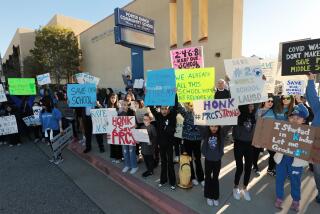Aldama Elementary’s two missions
My 9-year-old son was making a sandwich the other day when he burst into tears. He’d just learned that yet another classmate wouldn’t be coming back next year to his school, a Spanish-immersion program at a low-income campus in Highland Park. This friend, like others before her, was departing for a “better” school in a wealthier neighborhood.
When the Dual Immersion Program at Aldama Elementary opened four years ago, with a cadre of dedicated teachers and a group of idealistic, involved parents, I thought the hard work was over. After years of effort to get the program going, it seemed that we’d finally managed to achieve something important and rare: an excellent academic program with classrooms that were truly diverse, drawing kids from not just across ethnic lines but also across class and language lines.
My son, who entered kindergarten in the first year of the program, is about to enter fourth grade, and he’s flourishing. He speaks perfectly accented Spanish and is near the top of his class academically. He’s dedicated to his teachers, some of whom have become family friends. It would seem ideal — if it weren’t for a steady flow of friends leaving.
A few of those who departed did so because of job relocations or other moves. But more often, I’ve heard people say they were leaving for “better” schools. They say that other schools just have more: More challenging curricula. More parent involvement. More direct conduits to high school. More students who walk in the door at an advanced level because of the enrichment their families provide.
I am sure that the departing families made decisions they thought were best for their children, and that has to be respected. But having been involved with the Aldama program from the start, I believe its mission transcends just my children’s education. I believe in the close community the program has created among groups of people who don’t mix much in Los Angeles. These ties have helped bring enrichment to a struggling school. But they’ve also brought an enormous amount to my son and to our family.
Aldama struggles with all the problems of schools in disadvantaged communities. Our API score has yet to break the target set by the California Department of Education of 800 points (out of a possible 1,000). Many of Aldama’s working-class families don’t have the time, energy or understanding to host spaghetti fundraisers, and they certainly can’t write checks for thousands of dollars per family, as happens at schools such as Mt. Washington or Ivanhoe, two highly regarded Los Angeles Unified School District elementary schools on the Eastside. Some students come to school less kindergarten-ready than others, and their families are sometimes unable to help with homework. Some even come from families that don’t value education.
This understandably worries the middle-class parents in our school. Will their kids suffer academically or socially? Will their love of learning be undermined? Would they be better off in middle-class schools where the readiness levels are more even and the classes more homogenous?
That’s certainly possible. For decades, many California schools have grouped kids by ability level on the theory that this is best for all concerned. But research on the subject isn’t at all clear-cut. Some scholars have found that homogenous grouping doesn’t do much to improve achievement, and others have gone beyond that to assert that a more diverse classroom improves the cognitive development of all students. I tend to think, as many studies have suggested, that a successful classroom depends less on classroom composition and much more on the quality of faculty and curriculum.
And I do think that kids in Aldama’s dual-language program are getting many things that will serve them well for the rest of their lives. Not only do the children in the program study and play with a far wider cross-section of kids than are found at most schools, they learn — really learn — another language.
The benefits to acquiring true bi-literacy at a young age are numerous, according to studies. By sixth grade, such students outperform their nonbilingual counterparts on standardized tests. They have improved abstract and creative thinking as well as better overall cognitive development. And they also have a higher college acceptance rate.
All that said, my son’s teary sandwich shook me to the core. Were we depriving our children of important learning opportunities? Were the struggles of piloting a program too much? Should we too consider moving on? I even went so far as to drive around Sierra Madre looking at houses that were for sale. My son was with me, and he thought that Sierra Madre was beautiful. But he didn’t want to move there. He said it would be too long a commute to Aldama, and he wasn’t willing to consider changing schools.
His adamant stance reminded me how far we’ve come since the program started in 2008. We’ve put on talent shows, concerts, movie nights and art fairs. We have a presence in the business community and waiting lists for students to enter kindergarten and first grade. Our faculty has raised almost $100,000 for professional development and classroom libraries. And the commitment by teachers, families and students has been astonishing.
I realized my son was right. Aldama is our home.
Courtney Everts Mykytyn is an anthropologist and founding parent of Aldama’s Dual Immersion Program.
More to Read
A cure for the common opinion
Get thought-provoking perspectives with our weekly newsletter.
You may occasionally receive promotional content from the Los Angeles Times.






